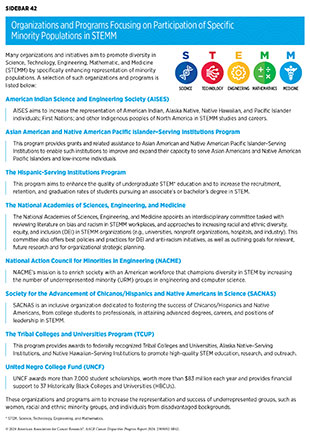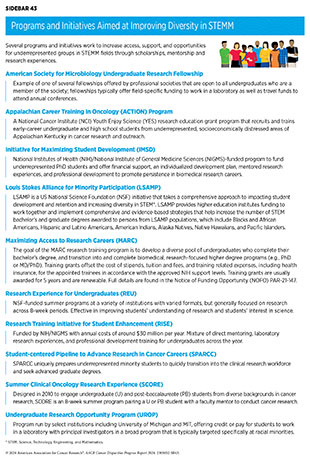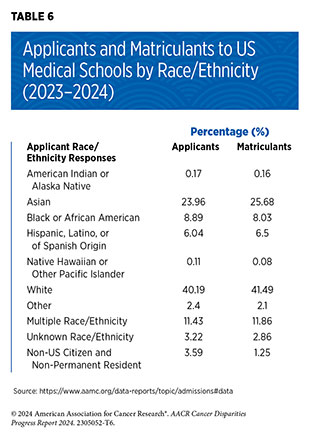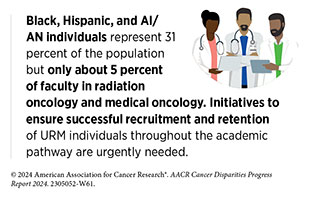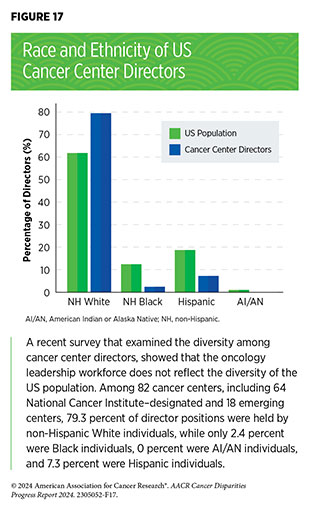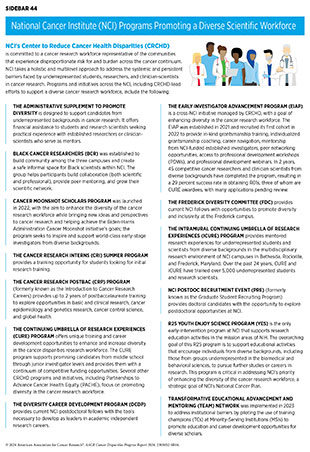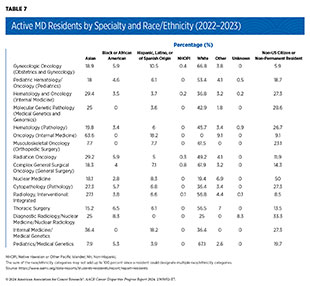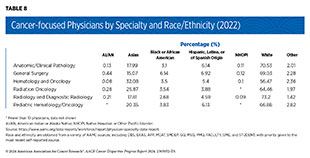Overcoming Cancer Disparities Through Diversity in Cancer Training and Workforce
In this section, you will learn:
- Certain demographic groups such as women, disabled individuals, some racial and ethnic minority groups, and sexual and gender minority groups are considerably underrepresented in the cancer research and care workforce.
- It is imperative to prioritize investment in early-career researchers to enhance diversity and improve equity in the workforce.
- Diversity-focused training has improved inclusion within the cancer research and care workforce; however, gaps remain throughout the cancer research training path and workforce.
- Improved support from medical research mentors and peer groups is needed to support diverse researchers and address cancer disparities.
- The Supreme Court’s ruling on race neutrality may negatively impact equitable representation in cancer science and medicine.
A diverse cancer research and patient care workforce includes individuals who represent a wide range of backgrounds, lived experiences, and demographic groups, including differences in race, ethnicity, sexual orientation and gender identity, disability status, and socioeconomic backgrounds (923)Winkfield KM, et al. (2017) Am Soc Clin Oncol Educ Book, 37: 18. [LINK NOT AVAILABLE](924)Center to Reduce Cancer Health Disparities. The CURE Paradigm: Enhancing Workforce Diversity. Accessed: March 27, 2024. . Diversity, equity, inclusion, and accessibility fundamentally strengthens cancer care and research by harnessing talent, overcoming systemic biases, delivering patient-centered care, and fostering collaboration.
A diverse cancer care workforce that reflects the diversity of the US population is critically important for several reasons. For example, it enhances cultural competence and humility in delivering care to a diverse patient population. Furthermore, a diverse workforce is better equipped to understand and meet the needs of all patients. It also builds public trust and participation in cancer research by having representative stakeholders involved in research and institutional processes (925)Thomas AG, et al. (2023) Oncologist, 28: e1131. [LINK NOT AVAILABLE].
Studies show that patients tend to have more positive health care experiences when their provider shares a similar racial or ethnic background (114)KFF. Survey on Racism, Discrimination and Health: Experiences and Impacts Across Racial and Ethnic Groups. Accessed: March 17, 2024. . Diversity in cancer care workforce fosters innovation and problem-solving by integrating different perspectives, insights and approaches to cancer research and clinical care. For instance, women remain underrepresented in medicine (926)Liblik K, et al. (2022) Res Pract Thromb Haemost, 6: e12767. [LINK NOT AVAILABLE], but they are more likely than male physicians to follow evidence-based practice (927)Tsugawa Y, et al. (2017) JAMA Intern Med, 177: 206. [LINK NOT AVAILABLE] and to engage in more preventive services (e.g., cancer screening) and communication (e.g., information-giving, partnership-building) (928)Mast MS, et al. (2018) Patient Educ Couns, 101: 1697. [LINK NOT AVAILABLE]. Therefore, a medical workforce that mirrors the US gender distribution is vital. Finally, efforts to enhance workforce diversity elevates role models and mentors to inspire and support the next generation of historically underrepresented professionals in the cancer research and patient care workforce.
The scientific community must acknowledge and mitigate discriminatory practices and policies that prevent promising and talented scientists, researchers, and clinician-scientists from underrepresented populations from fully contributing to the scientific community.
Science, Technology, Engineering, Mathematics, and Medicine Educational Landscape
STEMM, which stands for Science, Technology, Engineering, Mathematics, and Medicine, serves as an umbrella term for a number of fields that lay the foundation for entry into the health care professions (929)National Center for Education Statistics. Science, Technology, Engineering, and Mathematics (STEM) Education, by Gender. Accessed: March 26, 2024. .
Most STEMM disciplines and occupations lack diversity. In 2023, the National Center for Science and Engineering Statistics released a report on diversity trends in STEMM employment and education. The report found that various population groups are underrepresented in STEMM fields. These groups include racial and ethnic minority populations, women, individuals from low SES backgrounds, people who reported a disability, those belonging to the sexual and gender minority community, and those who are the first in their families to attend college (930)National Center for Science and Engineering Statistics. Diversity and STEM: Women, Minorities, and Persons with Disabilities 2023. Special Report NSF 23-315. Accessed: March 26, 2024. .
One major driver for lack of diversity in STEMM is rooted in the educational system. Students who attend underresourced pre-K–12 schools often face obstacles that can severely restrict their ability to pursue STEMM careers. Studies show that exposure and access to STEMM experiences in the early years are especially effective for increasing interest in STEMM careers. However, these opportunities are often not easily accessible to students from disadvantaged backgrounds, particularly those attending schools in low-income communities (931)Callis-Duehl K, et al. (2023) J STEM Outreach, 6: 1. [LINK NOT AVAILABLE].
People from racial and ethnic minority groups are underrepresented in STEMM fields. According to a recent Pew Research Center report, while 62 percent of White students have a STEMM degree, just 2.2 percent of Hispanic or Latino/a students, 2.7 percent of Black students, and 3.3 percent of AI/AN students have earned a university degree in STEMM fields. Furthermore, 52 percent of those surveyed believed this lack of representation was due to a lack of educational opportunities for people from racial and ethnic minority groups, and 45 percent believed the cause was lack of encouragement at an early age to pursue STEMM-related subjects (932)Pew Research Center. Blacks in STEM jobs are especially concerned about diversity and discrimination in the workplace. Accessed: March 17, 2024. . Finally, about one-third of those surveyed also attribute this underrepresentation to a lack of belief in their ability to succeed in these fields, the lack of diverse role models in these fields, and discrimination in recruitment, hiring, and promotions.
Diversifying the future cancer research workforce requires that students choose paths toward STEMM fields and engage in cancer research (933)National Academies of Sciences, Engineering, and Medicine. 2019. The Science of Effective Mentorship in STEMM. Washington, DC: The National Academies Press. . In recognition of the challenges faced by students from underrepresented groups, the Center to Reduce Cancer Health Disparities (CRCHD) CURE program offers unique training and career development opportunities to enhance and increase diversity in the cancer and cancer disparities research workforce. The CURE program supports promising candidates from middle school through junior investigator levels and provides them with a continuum of competitive funding opportunities. One of the goals of the CURE program is to support middle school, high school, and undergraduate students interested in cancer and cancer disparities research to enter the research field, work directly with scientists and community leaders, gain laboratory experience, and develop research skills (934)National Cancer Institute. Continuing Umbrella of Research Experience (CURE). Accessed: July 5, 2023. .
The federal government has established or expanded initiatives to enable participation in STEMM education programs and created pathways for people from diverse backgrounds to pursue careers in STEMM fields. The National Science Foundation (NSF) leads many programs and initiatives aimed at broadening participation, including programs in informal STEMM learning, pre-K–12 science education, undergraduate and graduate training in the sciences and engineering, and career support mechanisms for early-career academic researchers (935)US National Science Foundation. Broadening Participation in STEM. Accessed: March 17, 2024. . Many of these programs were created or expanded through provisions of the 2022 Creating Helpful Incentives to Produce Semiconductors (CHIPS) and Science Act (936)Congress.gov. Chips and Science Act. Accessed: March 26, 2024. . The CHIPS and Science Act aims to support historically underserved students and communities by providing new initiatives and funding to Historically Black Colleges and Universities (HBCUs), minority-serving institutions (MSIs), and other academic institutions. The CHIPS and Science Act also focuses on increasing the geographic diversity of research and innovation funding, combating sexual and gender-based harassment in the sciences, and supporting learners, educators, and researchers at minority-serving and emerging research institutions in rural communities. These investments and initiatives are designed to create a more inclusive STEMM environment that represents and benefits all Americans, regardless of their background or experience (937)US National Science Foundation. NSF’s Eddie Bernice Johnson Inclusion Across the Nation of Communities of Learners of Underrepresented Discoverers in Engineering and Science Initiative. Accessed: March 17, 2024. (938)The White House. FACT SHEET: CHIPS and Science Act Will Lower Costs, Create Jobs, Strengthen Supply Chains, and Counter China | The White House. Accessed: March 30, 2024. .
The federal strategy to improve STEMM career pathways also includes building capacity at MSIs and other underresourced colleges and universities. These include programs managed by the Department of Education, NSF, and other federal agencies to expand educational and research opportunities at HBCUs, Tribal Colleges and Universities, Hispanic-Serving Institutions, and Asian American and Native American or Pacific Islander– Serving Institutions.
One of the nation’s leading advocates for the importance of minority education and community engagement in STEMM is the United Negro College Fund (UNCF). UNCF awards more than 7,000 student scholarships, worth more than $83 million, each year, and provides financial support to 37 HBCUs. Since 1944, UNCF has helped to more than double the number of students from minority groups attending college. The 6-year graduation rate for UNCF Black scholarship recipients is 70 percent; this is 11 percent higher than the national average and 31 percent higher than the national average for all Black students (939)United Negro College Fund. United Negro College Fund. Accessed: March 17, 2024. . Another organization is the National Action Council for Minorities in Engineering (NACME). NACME provides scholarships, resources, and opportunities for high-achieving, underrepresented college students pursuing careers in engineering and computer science (see Sidebar 42) (940)National Science Foundation. Historically Black Colleges and Universities – Excellence in Research (HBCU – EiR). Accessed: March 26, 2024. (941)National Science Foundation. Tribal Colleges and Universities Program (TCUP). Accessed: March 26, 2024. (942)National Science Foundation. Improving Undergraduate STEM Education: Hispanic-Serving Institutions (HSI Program). Accessed: March 26, 2024. (943)National Action Council for Minorities in Engineering. About NACME. Accessed: March 26, 2024. (944)US Department of Education. Asian American and Native American Pacific Islander-Serving Institutions Program. Accessed: March 26, 2024. .
Within the National Cancer Institute (NCI), the R25 Youth Enjoy Science (YES) Research Education Program funds nonprofit- and government-based research programs for high school and undergraduate students with the dual
goal of increasing cancer knowledge and awareness among underrepresented students while also preparing these students to participate in careers in medical research (945)Parsons JRM, et al. (2021) J STEM Outreach, 4. [LINK NOT AVAILABLE]. These programs have primarily focused on promoting cancer research training to underrepresented racial and ethnic minority youth populations (946)Alfred L, et al. (2011) J Cancer Educ, 26: 223. [LINK NOT AVAILABLE](947)Hein DW, et al. (2018) J Cancer Educ, 33: 298. [LINK NOT AVAILABLE](948)Qua K, et al. (2020) Ethn Dis, 30: 15. [LINK NOT AVAILABLE]. Some examples of programs designed to increase diversity in STEMM fields are summarized in Sidebar 43.
The Diversity in Cancer Research (DICR) is a collaborative program engaging historically black medical schools to improve diversity, equity, and inclusion in cancer research. The program aims to build a more inclusive research community, address health disparities, and provide support for minority cancer researchers through institutional development grants, mentorship, and career development opportunities. The initiative is expected to contribute to the advancement of health equity and the improvement of cancer care outcomes for underrepresented populations.
In December 2022, the White House Office of Science and Technology Policy outlined five action areas for STEMM equity and excellence. Those areas are the following: ensuring adequate support for students, teachers, workers, and communities to participate in and contribute to STEMM in their lifetime; addressing the STEMM teacher shortage by expanding and enhancing pathways for the training, hiring, and professional success of a diverse teacher workforce; closing the funding gap and developing long-term investment plans for historically underfunded communities; creating solutions to address bias, discrimination, and harassment in classrooms, labs, and workplaces; and promoting accountability in STEMM (949)The White House. Equity and Excellence: A Vision to Transform and Enhance the U.S. STEMM Ecosystem. Accessed: March 17, 2024. .
Basic and Translational Cancer Research Workforce Landscape
Basic and translational cancer research are two interconnected areas of research that aim to improve our understanding of cancer biology and develop new strategies for cancer prevention, diagnosis, and treatment. Basic cancer research focuses on understanding the fundamental mechanisms and processes that underlie cancer development, progression, and spread. Translational cancer research, on the other hand, aims to “translate” the findings from basic cancer research into clinical applications that can benefit cancer patients. This type of research serves as a bridge between basic science discoveries and clinical practice. Promoting diversity in cancer research ensures that findings reflect the diverse populations affected by cancer and contributes to the development of more effective and equitable interventions. Diversifying the research workforce applies to higher education, researchers from academic institutions, editorial boards of peer-reviewed scientific journals, and conference speakers and participants (950)Boulware LE, et al. (2022) N Engl J Med, 386: 201. [LINK NOT AVAILABLE]. In higher education, for instance, a diverse learning environment promotes students’ exploration of diverse perspectives, reduces racial prejudice, and increases understanding of alternative points of view and other human differences (951)Office of Planning, Evaluation and Policy Development. US Department of Education. Advancing Diversity and Inclusion in Higher Education. Accessed: March 17, 2024. .
New and junior underrepresented cancer researchers and clinician-scientists encounter persistent challenges rooted in systemic racism along their career paths, which Black students and scientists disproportionately experience. According to the Advisory Committee to the Director Working Group on Diversity of National Institutes of Health (NIH), Black scientists make up 7.7 percent of the scientific workforce despite representing 12.4 percent of the US population. Moreover, only 1 percent of postdoctoral awards go to Black applicants. While the number of R01 grants awarded to Black researchers increased between 2013 and 2018, only 2 percent of all R01 grants were awarded to Black researchers or clinical scientists in 2018 (952)The Advisory Committee to the Director Working Group on Diversity. Racism in Science Report. Accessed: March 17, 2024. . Data from 2013 to 2020 show that, compared to White applicants, Black applicants had a lower likelihood of receiving R01 funding (10.7 percent vs. 17.7 percent) and were less likely to resubmit unfunded applications (37.4 percent versus 50.0 percent) (953)Taffe MA, et al. (2021) eLife, 10: 1. [LINK NOT AVAILABLE].
The lack of diversity in basic and translational cancer research may be reflective of the underrepresentation of racial and ethnic minority groups in health care overall. This underrepresentation may be attributed to disparities in the application, matriculation, and completion of professional and graduate school among these individuals. Multiple barriers contribute to the underrepresentation of certain racial and ethnic groups in health care, including differences in parental educational level, ineffective evaluation and metrics of performance and scientific potential, social and cultural factors, financial barriers, systemic racism (954)Cadena MA, et al. (2023) Cell, 186: 3529. [LINK NOT AVAILABLE], and differences in the networks and other extracurricular educational opportunities valued in the medical school application process (955)Faiz J, et al. (2023) JAMA Health Forum, 4: e230498. [LINK NOT AVAILABLE].
Lack of diversity in academic medicine overall is another factor contributing to inequities in the matriculation of students who are underrepresented in medicine. Data from the Association of American Medical Colleges (AAMC) show that over 83 percent of the medical school faculty is White or Asian (956)Association of American Medical Colleges. AAMC Data & Reports. Accessed: March 27, 2024. . This lack of faculty diversity could potentially lead to admissions committees that are prone to unconscious racial bias (957)Association of American Medical Colleges. Unconscious Bias in Faculty and Leadership Recruitment: A Literature Review. Accessed: March 17, 2024. . In 2023, representation of groups based on race or ethnicity was uneven relative to the proportion of these groups in the US population. Persons from many racial and ethnic minority groups—such as Hispanic or Latino, Black, and AI/AN populations—are underrepresented in medical schools when compared to their proportion of the total population. In 2023, Black people made up 12.4 percent of the total population, but only 8 percent of medical school applicants and matriculants were Black. Hispanic or Latino/a people made up 18.7 percent of the total population, but only 6 percent of medical school applicants and matriculants were Hispanic or Latino/a. AI/AN individuals made up 1.1 percent of the total population, but only 0.17 percent of medical school applicants and matriculants were AI/AN individuals (956)Association of American Medical Colleges. AAMC Data & Reports. Accessed: March 27, 2024. (see Table 6).
Although the diversity of medical school applicants, matriculants, and graduates has increased during the past 10 years, these increases are not translating to a better representation at the faculty level or at higher levels of leadership in medicine (958)Mass General Research Institute. Study Finds More Efforts Are Needed to Increase Diversity Among Cancer Clinicians. Accessed: March 17, 2024. . The cancer science and medicine faculty at academic medical centers plays an important role in training the next generation of researchers and clinicians. It is important that the faculty is fully reflective of the US population to adequately train future oncologists who will provide care to a diverse patient population.
Affirmative action relates to procedures that seek to eliminate discrimination and to support people who have been historically discriminated against (959)Sottile E, et al. (2023) J Gen Intern Med: s11606. [LINK NOT AVAILABLE]. In June 2023, the Supreme Court invalidated admissions programs at Harvard University and the University of North Carolina (UNC) system that took race into consideration as a specific basis in admissions. The Court held that Harvard and UNC’s admissions programs, which account for race at various stages in the process, violate the Equal Protection Clause of the Fourteenth Amendment to the US Constitution. State bans on affirmative action previously caused minority student enrollment to drop 5 percentage points (960)Ly DP, et al. (2022) Ann Intern Med, 175: 873. [LINK NOT AVAILABLE]. In addition to disproportionate underrepresentation of minority groups in medical schools, in the years since state-level bans on affirmative action were implemented, public medical schools in ban states had significant drops in the proportion of historically underrepresented students compared to the years prior to the ban (960)Ly DP, et al. (2022) Ann Intern Med, 175: 873. [LINK NOT AVAILABLE]. The recent Supreme Court ruling has the potential to amplify this effect on the enrollment of historically underrepresented groups nationally (961)Pereira RI, et al. (2024) Lancet, 403: 332. [LINK NOT AVAILABLE].
The largest bottleneck in the academic scientist training pathway is securing and maintaining a tenure-track faculty position, which is widely seen as the most challenging step for academic scientists looking to establish independent
research careers. A postdoctoral research position is a transition path between graduate school and becoming an independent investigator. Unfortunately, low salaries not only are a deterrent for graduate students to apply for postdoctoral fellowships, but also result in burnout and lack of research productivity. A key advisory group at NIH has recommended raising the minimum salary for postdoctoral researchers. However, the plan faces uncertainty, as it requires approval by NIH leadership. If implemented, the postdoctoral pay boost may improve both recruitment and retention of talented early-career scientists at NIH-funded labs across the country (963)Science. NIH advisory group recommends $14,000 boost in postdoc pay. Accessed: March 17, 2024. . Policymakers seeking to address this issue and ensuring that the next generation of scientists have viable career options should focus on measures to increase federal research budgets and incentivize universities to expand their available faculty positions.
Intentional, unrelenting, and multilevel interventions are urgently needed to course-correct the systematic, institutionalized, and persistent barriers that prevent people from minoritized communities from thriving in medical research. NIH has embarked on an agency-wide effort to enhance diversity and dismantle structural racism in the medical research community. A central part of this is the UNITE initiative, focused on enhancing health disparities research, and promoting inclusion and diversity within both intramural NIH programs and the extramural medical and behavioral research workforce (964)National Institutes of Health. Ending Structural Racism. UNITE. Accessed: March 17, 2024. . Though much work remains to be done, through the UNITE framework, NIH has begun to allocate funds for research, share data regarding funded researchers, develop new science education programs, and enhance grant programs to help diversify the biomedical workforce (965)The National Institutes of Health. The UNITE Progress Report 2021-2022. Accessed: March 17, 2024. .
Racial and ethnic minority groups, women, or individuals from sexual or gender minority groups face systemic barriers to leadership positions in higher education and health care. The lack of diversity among senior leadership limits the range of perspectives and experiences guiding journal policies, peer review, and conference agendas. Leadership at cancer centers remains predominantly White. According to a recent survey, among 82 cancer centers, including 64 National Cancer Institute (NCI)–designated and 18 emerging centers, 79 percent of director positions were held by non-Hispanic White individuals (see Figure 17). This underrepresentation of racial and ethnic minority groups may result in a lack of diverse perspectives when major decisions are made about cancer research priorities and resource allocation (966)Lerman C, et al. (2022) J Natl Cancer Inst, 114: 1214. [LINK NOT AVAILABLE].
In 2022, the NCI introduced a new requirement for all NCI-designated cancer centers to develop and implement a Plan to Enhance Diversity. This plan aims to promote diversity, equity, and inclusion in the cancer research workforce and address disparities in cancer prevention, diagnosis, and treatment. The requirement is part of the Cancer Center Support Grant (CCSG) application process and emphasizes the importance of fostering a diverse and inclusive environment within NCI-designated cancer centers. Centers are expected to outline strategies to recruit, retain, and support individuals from underrepresented backgrounds in cancer research and patient care.
Within NCI, the Center to Reduce Cancer Health Disparities (CRCHD) is leading the initiatives to train students, researchers, and clinician-scientists from underrepresented communities in cancer and cancer disparities research. CRCHD addresses career development gaps through a holistic and multilevel approach to increase the number of underrepresented researchers and clinician-scientists by offering various pathways across the academic cancer research continuum, which has proven effective (see Sidebar 44).
Cancer Care Workforce Landscape
Physicians
Despite many diversity initiatives over the past 10 years, underrepresentation of racial and ethnic minority groups, sexual and gender minority groups, and individuals from low socioeconomic status continues in the oncology workforce (see Table 7 and Table 8). In 2023, on average, just 4.1 percent of cancer-focused medical residents were Black. For those of Hispanic ethnicity, the percentage was 5.3 percent. AI/ AN individuals represented 0.46 percent of the cancer-focused residents and only 0.17 percent were NHOPI residents (967)Association of American Medical Colleges. Report on Residents. Accessed: March 17, 2024. .
Similarly, a 2022 survey of 80,299 cancer-focused physicians found that 3.93 percent identified as Black, and 0.23 percent were AI/AN individuals. Only 5.6 percent were Hispanic or Latino/a individuals and 0.09 percent were NHOPI individuals (968)Association of American Medical Colleges. Physician Specialty Data Report. Accessed: March 17, 2024. . The Association of American Medical Colleges (AAMC) 2022 Physician Specialty Data Report indicated that the share of medical students who are women; Black; or Hispanic, Latino/a, or of Spanish origin has grown in the 2022–2023 school year. Additionally, the report found that 37.1 percent of active physicians in the United States were women in 2021, up from 28.3 percent in 2007.
Diversity in the medical workforce may improve outcomes and access to care for patients from minority groups. Research shows that having more Black doctors is associated with better survival-related outcomes, lower all-cause mortality rates, and fewer mortality rate disparities for Black individuals (969)Snyder JE, et al. (2023) JAMA Netw Open, 6: e236687. [LINK NOT AVAILABLE]. Although Black physicians make up less than 5 percent of all US physicians, they care for 25 percent of Black patients (970)Daley GQ, et al. (2021) Med, 2: 2. [LINK NOT AVAILABLE]. Within oncology, the number of Black physicians is just 3 percent with minimal increase in fellowship applications for Black trainees over the past decade (971)Winkfield KM, et al. (2021) JCO Oncol Pract, 17: 224. [LINK NOT AVAILABLE]. To increase the number of Black physicians, medical schools must recognize and address the systemic challenges associated with these goals. These challenges are structural, faced by racial and ethnic minority groups, and are endured for generations. A strong educational pathway must be developed, including working alongside undergraduate institutions, particularly HBCUs, to identify and help develop promising potential Black medical students (972)Shuler HD, et al. (2022) Cell, 185: 2841. [LINK NOT AVAILABLE].
The issue of underrepresentation also persists among the Hispanic population. Oncologists who identify as Hispanic/Latino remain highly underrepresented in the workforce (973)ASCO (2022) JCO Oncol Pract, 18: 396. [LINK NOT AVAILABLE]. While the Latino population is the largest minority group in the United States, constituting 18.7 percent of the total population, less than 5 percent of practicing oncologists in the United States self-identify as Hispanic or Latino, and only 7 percent of matriculating medical school students self-identify as Hispanic or Latino, of which only a fraction will go on to pursue oncology training (974)Duma N, et al. (2022) JCO Oncol Pract, 18: 388. [LINK NOT AVAILABLE]. Physicians of Black, AI/AN, and Latino origin are more likely to practice in areas federally designated as medically underserved (975)Xierali IM, et al. (2018) J Health Care Poor Underserved, 29: 556. [LINK NOT AVAILABLE]. Furthermore, a shortage of Spanish-speaking physicians could negatively impact the health care quality and access for Hispanic or Latino patients whose preferred language is Spanish (976)Balderas-Medina Anaya Y, et al. (2022) Acad Med, 97: 398. [LINK NOT AVAILABLE].
Besides oncologists, obstetrician-gynecologists (Ob-Gyns) and urologists play pivotal roles in prevention, detection, diagnosis, supportive services, and survivorship care for patients with cancer. A recent study shows higher proportions of Ob-Gyn residents who identified as Black (10.2 percent) or Hispanic (9.6 percent) compared with surgical and nonsurgical specialties. While Ob-Gyns do have a higher proportion of Hispanic and Black medical residents compared to other specialties, their numbers still fall below that of the general population (977)Lopez CL, et al. (2021) JAMA Netw Open, 4: e219219. [LINK NOT AVAILABLE]. According to statistics published in the 2021 Census Reports from the American Urological Association (AUA), the following is a current breakdown of the racial landscape in this field: Out of 13,790 practitioners, 83 percent are White, 2.4 percent are Black, and 4.4 percent are Hispanic individuals. The AUA recommends including educational efforts that inform our diplomates and committee members about the benefits of diversity (978)Husmann DA, et al. (2021) Urol Pract, 8: 583. [LINK NOT AVAILABLE].
Medicare is the largest funder of graduate medical education (GME) in the United States, supporting over 98,000 residency positions through payments to teaching hospitals (979)Congressional Research Service. Medicare Graduate Medical Education Payments: An Overview. Accessed: March 17, 2024. (980)American Medical Association. 2023 Compendium of Graduate Medical Education Initiatives Report. Accessed: March 17, 2024. . In 1997, Congress passed the Balanced Budget Act, which froze the number of Medicare-funded residency positions at 1996 levels (981)Salsberg E, et al. (2008) JAMA, 300: 1174. [LINK NOT AVAILABLE]. This cap remains and has created a bottleneck that limits the number of new physicians who can enter the workforce each year.
Rural and urban underserved community programs rely more heavily on Medicare funding for residency positions, which has made practicing in underserved areas challenging. In 2020, only 2 percent of Medicare-funded residency training occurred in rural areas (982)Rains J, et al. (2023) JAMA, 330: 968. [LINK NOT AVAILABLE]. Studies have also shown that rural background among trainees and rural exposures during medical school were associated with higher rural practice uptake (983)Kwan MMS, et al. (2017) PLoS One, 12: e0180394. [LINK NOT AVAILABLE](984)Playford D, et al. (2017) Aust J Rural Health, 25: 210. [LINK NOT AVAILABLE](985)McGrail MR, et al. (2018) Hum Resour Health, 16: 56. [LINK NOT AVAILABLE], and physicians often practice within 100 miles of where they completed residency. Therefore, training residents where they are needed in practice is one promising strategy to increase the supply of rural physicians (986)Goodfellow A, et al. (2016) Acad Med, 91: 1313. [LINK NOT AVAILABLE](987)Fagan EB, et al. (2013) Am Fam Physician, 88: 704. [LINK NOT AVAILABLE].
A 2023 study found that less than 30 percent of medical students planned to practice in underserved areas between 2019 and 2021; those who did were more likely to be women, belong to minoritized populations, or identify as a member of the SGM community (988)Dyrbye LN, et al. (2023) JAMA, 330: 1797. [LINK NOT AVAILABLE]. The lack of residency training in rural and underserved areas worsens the uneven distribution of physicians. Congress recently took steps to support several programs supporting GME funding by adding 1,000 new Medicare-funded positions for the first time since 1997 (989)Schleiter K, et al. (2021) J Grad Med Educ, 13: 602. [LINK NOT AVAILABLE]. Advocacy efforts continue for lifting the cap on Medicare GME funding and expanding physician workforce capacity.
In summary, diversity brings valuable new perspectives and ways of thinking that benefit research, education, and care delivery. A physician workforce that adequately represents the diversity of the general population has the potential to improve patient outcomes, experiences, and access to high-quality care. A concerted effort is needed to attract, support, and retain a diverse medical workforce.
Physician-Scientists
Physician-scientists with combined MD and PhD training play a vital role in medical research. While only 4 percent of medical school graduates are MD-PhDs, almost half of NIH research funding distributed to physicians is allocated to MD-PhD researchers (990)National Institutes of Health. Physician-Scientist Workforce Working Group Report. Accessed: March 17, 2024. . MD-PhD physician-scientists can seamlessly transition between bench and bedside, conducting impactful research while keeping the focus on serving patients (991)Bannerman C, et al. (2020) Mol Biol Cell, 31: 2640. [LINK NOT AVAILABLE].
During the past decade, diversifying efforts have resulted in a consistent and sustained increase in the share of female and underrepresented minority (URM) in medicine matriculants to MD-PhD programs. Yet, there is much room for improvement to include more women, Black, Hispanic, AI/AN, and NHOPI individuals in the MD-PhD population in the United States (see Table 9). Both NIH and Congress have cited this stark lack of gender and racial and ethnic diversity among MD-PhDs as an issue of concern that needs to be addressed urgently (992)Ayedun A, et al. (2023) JAMA Netw Open, 6: e2310795. [LINK NOT AVAILABLE].
Attrition rates among URM MD-PhD students, including those who identify as Black, Hispanic or Latino(a), and AI/AN, are disproportionately high (993)Siebert AL, et al. (2020) BMC Med Educ, 20: 422. [LINK NOT AVAILABLE]. Studies indicate that about 25 percent of URM students withdraw from combined degree programs, compared to less than 10 percent of non-URM students. According to a recent study, among more than 4,700 students enrolled in combined MD-PhD programs, overall 84 percent of students completed their training. However, compared to 17 percent of White students, 29 percent of Black students did not complete their MD-PhD training. Furthermore, Black students were more likely than their White counterparts to leave medical school (994)Nguyen M, et al. (2023) JAMA Intern Med, 183: 1021. [LINK NOT AVAILABLE].
Factors contributing to high rates of attrition likely include a lack of mentors with shared backgrounds, feelings of isolation, imposter syndrome, and insufficient research funding for URM trainees (991)Bannerman C, et al. (2020) Mol Biol Cell, 31: 2640. [LINK NOT AVAILABLE]. The high attrition of minority MD-PhD students is an unacceptable loss of talent and perpetuates inequities in representation within academic medicine and medical research. Proactive measures to boost enrollment, provide funding, and retain URM MD-PhD students through graduation are essential for diversifying the physician-scientist workforce.
In a 2023 Consensus Report published by the National Academies of Sciences, Engineering, and Medicine, national experts in STEMM industries recommended that leaders systematically interrogate the causes perpetuating disparities in educational and career outcomes. The report serves as a roadmap for government, educational institutions, and other stakeholders to acknowledge and address the historical underpinnings of today’s injustices (995)In: Vargas EA, Scherer LA, Fiske ST, Barabino GA, editors. Advancing Antiracism, Diversity, Equity, and Inclusion in STEMM Organizations: Beyond Broadening Participation. Washington (DC)2023. [LINK NOT AVAILABLE].
Policy changes at institutional, funding agency, and federal levels are needed to drive meaningful improvements in participation of underrepresented groups in cancer research. Some solutions include the following: offering focused scholarship programs to incentivize and support URM students in pursuing MD-PhD programs to help lower financial barriers to entry; providing dedicated research funding opportunities for early-career physician-scientists from diverse backgrounds to promote retention and career development; setting clear diversity goals and collecting data on demographics to monitor representation in MD-PhD programs, faculty appointments, and leadership roles; expanding mentoring and networking programs to connect URM physician-scientists with senior researchers who can advise on career progression; and increasing exposure to research careers for minority undergraduate and high school students via pathway programs and partnerships with Minority-Serving Institutions (996)Krecko LK, et al. (2022) Health Equity, 6: 873. [LINK NOT AVAILABLE](997)The Chronicle. Opinion: Two Big Things Colleges Can Do Right Now to Increase Diversity. Accessed: March 17, 2024. .
In 2020, as a collaborative effort, the AACR and the Bristol Myers Squibb Foundation and National Medical Fellowships created an initiative named the Robert A. Winn Diversity in Clinical Trials Award Program (Winn CDA). The Winn CDA is a 2-year program designed to train early-stage physician scientists in the fundaments of clinical trial design and the science of community outreach and engagement. These physician-scientists are from underrepresented backgrounds and have demonstrated a commitment to increasing diversity in clinical research. To date, the Winn CDA has trained 179 early-stage investigators, with an additional 67 scheduled for 2024.
Other Health Care Professionals
While physicians have a central role in cancer care, they rely on the expertise and support of many other team members involved in caring for cancer patients, including nurses, physician assistants, pharmacists, radiation therapists, social workers, nutritionists, rehabilitation therapists, psychologists and counselors, and patient navigators.
Despite decades of effort, the nursing workforce remains mostly female and White. According to a 2022 survey, the nursing workforce lacks diversity, with 80 percent identifying as non-Hispanic White (998)Smiley RA, et al. (2023) J Nurs Regul, 14: S1. [LINK NOT AVAILABLE]. The number of Hispanic or Latino(a) registered nurses (RNs) increased from 3.6 percent in 2015 to 6.9 percent in 2022; 6.3 percent of RNs were Black, and AI/AN and NHOPI individuals both represented 0.4 percent of the nursing workforce. Male nurses accounted for 11.2 percent of the registered nurse workforce in 2022, with an increase of 1.8 percent since 2020 (998)Smiley RA, et al. (2023) J Nurs Regul, 14: S1. [LINK NOT AVAILABLE].
The Future of Nursing 2020–2030 report by the National Academy of Medicine emphasizes diversifying the nursing workforce as a key priority. Specifically, the report calls for expanding pathways and creating more seats for students from minority and disadvantaged backgrounds to access nursing schools, tailoring recruitment, and establishing retention strategies toward nurses from minority groups, including underrepresented racial and ethnic groups, men, sexual and gender minority individuals, immigrants, people with disabilities, veterans, and those living in rural areas (999)Hassmiller SB, et al. (2022) Nurs Outlook, 70: S1. [LINK NOT AVAILABLE].
Similar to the nursing workforce, the physician assistant (PA) workforce falls short of mirroring national demographics, mainly due to a lack of diversity in student enrollment. An analysis of PA programs in the United States in 2022 showed that during 2014–2018, PA programs had difficulty in recruiting and graduating a diverse group of students: out of 34,625 graduates, only 6.4 percent were of Hispanic ethnicity and 3.5 percent were from URM groups. Furthermore, diverse graduates came from a few top-performing programs (1000)Bradley-Guidry C, et al. (2022) BMC Med Educ, 22: 680. [LINK NOT AVAILABLE]. As part of the efforts to diversify the PA workforce, the Physician Assistant Higher Education Modernization Act was introduced in Congress in January 2021 to help enhance diversity among PAs by allocating more federal resources and funding to PA programs and initiatives aimed at recruiting and graduating more students from minority, disadvantaged and underserved backgrounds. The bill is currently in the early phases of being considered by Congress (1001)Congress.gov. Text – H.R.2274 – 117th Congress (2021-2022): Physician Assistant Higher Education Modernization Act of 2021. Accessed: March 17, 2024. .
While not directly administering cancer therapies, dentists play a key role in certain aspects of cancer care by detecting abnormalities in the mouth and throat during routine oral examinations that could lead to a diagnosis of cancer (1002)Harris JA, et al. (2022) Front Oral Health, 3: 874332. [LINK NOT AVAILABLE]. Among 202,304 dentists in the United States in 2023, 3.8 percent were Black individuals, 6 percent were from Hispanic groups, 0.3 percent were AI/AN people, and 0.2 percent were NHOPI individuals (1003)American Dental Association. U.S. Dentist Demographics. Accessed: March 17, 2024. .
Oncology pharmacists are crucial members of the cancer care team, ensuring safe and effective use of complex medications. They collaborate with health care professionals to optimize treatment, monitor patients, and educate patients and caregivers. Recent studies have highlighted disparities within the oncology pharmacy workforce, particularly in terms of representation, leadership opportunities, and access to specialized education and training. For instance, a 2019 survey by the Hematology/ Oncology Pharmacy Association (HOPA) found that while women made up 63 percent of HOPA’s membership, they held only 56 percent of leadership positions within the organization (1004)Shillingburg A, et al. (2020) J Oncol Pharm Pract, 26: 175. [LINK NOT AVAILABLE]; additionally, only 3.9 percent of pharmacists were Black, and 3.6 percent were Latino, compared to 76.9 percent who identified as White (1005)George A, et al. (2023) HCA Healthc J Med, 4: 77. [LINK NOT AVAILABLE]. These disparities extend to education and training, with a 2018 study finding that non-White oncology pharmacists were less likely to have completed a postgraduate year 2 (PGY2) oncology pharmacy residency, a training program for pharmacists who wish to specialize in the field of oncology pharmacy, compared to their White counterparts (20.3 percent versus 33.7 percent) (1006)Holle LM, et al. (2020) Pharmacy (Basel), 8: 130. [LINK NOT AVAILABLE]. These findings highlight the need for targeted efforts to increase diversity and inclusion within the oncology pharmacy workforce.
Next Section: Overcoming Cancer Disparities Through Science-based Public Policy Previous Section: Disparities in Cancer Survivorship